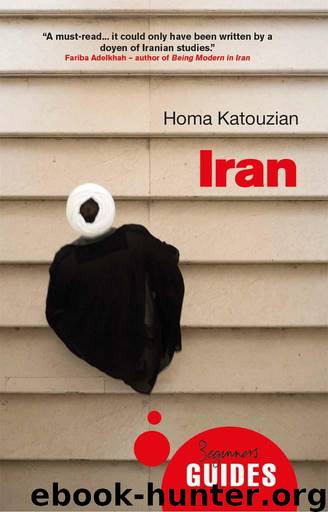Iran: A Beginner's Guide (Beginner's Guides) by Homa Katouzian

Author:Homa Katouzian
Language: eng
Format: mobi
ISBN: 9781780742731
Publisher: Oneworld Publications
Published: 2013-05-31T23:00:00+00:00
Dress code and forced unveiling
The official imposition of new dress codes, and even the forced removal of hejab, was based on another cherished nationalist modernist ideology. The law of December 1928 made it compulsory for all Iranian men to wear European dress (short jackets and trousers) and the ‘Pahlavi hat’, which was a variation on the French kepi. However, in 1935 the shah suddenly issued the decree that all men must wear the European chapeau or bowler hat, which most of them had never even seen. Unarmed protesters in Mashhad took sanctuary in the historic mosque adjacent to the shrine of Imam Reza, where, contrary to the traditional customs of taking bast, they were gunned down by police and soldiers. The shrine’s trustee (appointed by the shah himself), who had apparently tried to act as an intermediary, was blamed and summarily executed. He was related to Prime Minister Forughi, but the latter’s attempt at interceding with the shah led to his own downfall in disgrace. Shortly afterwards the shah told a sceptical Mokhber al-Saltaneh (Mehdiqoli Hedayat), the former prime minister, that the compulsory change of hat was intended to stop the Europeans from ‘ridiculing us’.
The shah’s sudden decree for the removal of the women’s hejab which followed a few months later in January 1936 was not openly resisted, coming so soon after the events in Mashhad over the European hat, but it left scars much deeper even than Reza Shah’s tribal policy. Criticisms of hejab by modern intellectuals went back to the turn of the twentieth century, and entered the realm of wider public discussion at least from the end of World War I among the modern middle and upper classes. Iraj, the leading satirical poet, wrote against hejab and blind marriage arrangements, and emphasized that the covering of hands and faces by women was contrary to the teaching of the Qur’an. Around 1918, the nationalist poet Eshqi wrote the long poem entitled The Black Shroud which ended with the verse: ‘As long as women live in shrouds / Half of the Iranian people are not alive.’
Women activists and self-help organizers began to campaign for women’s rights. The women’s journal Alam-e Nesvan (‘Women’s World’, 1920–34) which had been the longest-running journal of its kind over the period was shut down by the government, along with many other women’s journals, before the official banning of the hejab was enacted. The shah would not tolerate any independent journal or organization even if they fully supported his regime. They were replaced by the official Kanun-e Banuan (‘Ladies’ Centre’).
All the anti-hejab campaigners were opposed to the face veil, which some women had already abandoned in the 1920s. The more radical of them also opposed the chador. But they were not against scarves, and hardly any of them believed that all women should be forced to remove their veils, as opposed to voluntary unveiling protected by the law.
The new government decree meant that even scarves were banned. As Mokhber al-Saltaneh (Mehdiqoli Hedayat) wrote in his memoirs: ‘The police were ordered to pull the scarves off women’s heads.
Download
This site does not store any files on its server. We only index and link to content provided by other sites. Please contact the content providers to delete copyright contents if any and email us, we'll remove relevant links or contents immediately.
| Bahrain | Egypt |
| Iran | Iraq |
| Israel & Palestine | Jordan |
| Kuwait | Lebanon |
| Oman | Qatar |
| Saudi Arabia | Syria |
| Turkey | United Arab Emirates |
| Yemen |
Empire of the Sikhs by Patwant Singh(22977)
The Wind in My Hair by Masih Alinejad(5034)
Rise and Kill First by Ronen Bergman(4705)
The Templars by Dan Jones(4629)
The Rape of Nanking by Iris Chang(4139)
12 Strong by Doug Stanton(3509)
Blood and Sand by Alex Von Tunzelmann(3140)
Babylon's Ark by Lawrence Anthony(2622)
The History of Jihad: From Muhammad to ISIS by Spencer Robert(2572)
No Room for Small Dreams by Shimon Peres(2320)
The Turkish Psychedelic Explosion by Daniel Spicer(2314)
Gideon's Spies: The Secret History of the Mossad by Gordon Thomas(2305)
Inside the Middle East by Avi Melamed(2305)
Arabs by Eugene Rogan(2262)
The First Muslim The Story of Muhammad by Lesley Hazleton(2219)
Come, Tell Me How You Live by Mallowan Agatha Christie(2212)
Bus on Jaffa Road by Mike Kelly(2103)
Kabul 1841-42: Battle Story by Edmund Yorke(1986)
1453 by Roger Crowley(1967)
